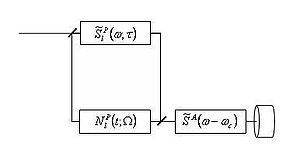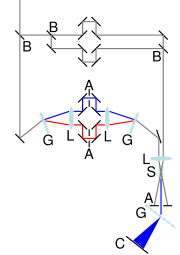
Spectral phase interferometry for direct electric-field reconstruction
Encyclopedia
In ultrafast optics, spectral phase interferometry for direct electric-field reconstruction (SPIDER) is an ultrashort pulse
measurement technique.
. Spectral shearing interferometry is similar in concept to lateral shearing interferometry, except the shearing is performed in the frequency domain. The spectral shear is typically generated by sum-frequency mixing the test pulse with two different quasi-monochromatic frequencies (usually derived by chirping a copy of the pulse itself). The interference between the two upconverted pulses allows the spectral phase at one frequency to be referenced to the spectral phase at a different frequency, separated by the spectral shear - the difference in frequency of the two monochromatic beams. In order to extract the phase information, a carrier fringe pattern is introduced, typically by delaying the two spectrally sheared copies with respect to one another.
 In a basic spectral shearing interferometer, the input beam is split into two identical pulses, sending one through a linear spectral phase modulator:
In a basic spectral shearing interferometer, the input beam is split into two identical pulses, sending one through a linear spectral phase modulator:
while the other is sent through a linear temporal phase modulator:
The two pulses are then recombined and sent through a spectrometer:
The linear spectral phase modulator is a time stationary, phase-only filter and adds spectral shear to pulses in its arm of the interferometer. The linear temporal phase modulator is frequency stationary, phase-only filter which adds temporal delay to the pulse in its arm. The spectrometer in which the pulses are recombined is a time stationary, amplitude-only filter which resolves with pass-band γ and center frequency ωc.
In this setup, the pulse through the temporal phase arm has its spectrum shifted by a spectral shear of Ω. In order to exactly measure a pulse, the field must be sampled by a certain number of spectrally sheared components. This sampling requirement is determined by the Nyquist–Shannon sampling theorem
. If the function has compact support on the interval τN, then it is completely determined by giving its values at a series of frequencies 2π/τN apart. This means that the spectral shear that needs to be generated by the SPIDER is Ω = 2π/τN.
The pulse through the spectral arm acquires a time-delay of τ. The recombination of the pulses from the two arms is then resolved by the spectrometer which produces a signal
containing the spectrometer function, which can be approximated by a delta function due to its pass-band, γ, being so much narrower than the spectrum of the input pulse. In addition, because the spectral and temporal delays are fixed, the only remaining variable is the center frequency, ω_c, of the spectrometer. The resulting signal
contains the spectrum of the input pulse, the spectrum of the sheared pulse, and the phase difference between the frequency components of the input pulse which were separated by the spectral shear.
The shearing interferogram created by this signal generally consists of fringes spaced at a frequency of 2π/τ. Deviations from the nominal fringe spacing can be analyzed to obtain the spectral phase of the field. The spectral amplitude must be obtained by a separate measurement of the pulse spectrum.

The two arms in a spectral shearing interferometer are implemented by means of a beam splitter
(B), Diffraction grating
(G), lens
(L), Aperture
(A), Charge-coupled device
C, and a method for sum frequency generation
(S).
These components make up the spectrometer
and optical delay line.
Ultrashort pulse
In optics, an ultrashort pulse of light is an electromagnetic pulse whose time duration is of the order of a femtosecond . Such pulses have a broadband optical spectrum, and can be created by mode-locked oscillators...
measurement technique.
The basics
SPIDER is an interferometric ultrashort pulse measurement technique in the frequency domain based on spectral shearing interferometryInterferometry
Interferometry refers to a family of techniques in which electromagnetic waves are superimposed in order to extract information about the waves. An instrument used to interfere waves is called an interferometer. Interferometry is an important investigative technique in the fields of astronomy,...
. Spectral shearing interferometry is similar in concept to lateral shearing interferometry, except the shearing is performed in the frequency domain. The spectral shear is typically generated by sum-frequency mixing the test pulse with two different quasi-monochromatic frequencies (usually derived by chirping a copy of the pulse itself). The interference between the two upconverted pulses allows the spectral phase at one frequency to be referenced to the spectral phase at a different frequency, separated by the spectral shear - the difference in frequency of the two monochromatic beams. In order to extract the phase information, a carrier fringe pattern is introduced, typically by delaying the two spectrally sheared copies with respect to one another.
Theory
There are two important specifications for filters: time/frequency response and amplitude/phase response. A filter is said to be time or frequency stationary if its output is unaffected by the time or frequency of the input. A filter can also be classified as amplitude-only or phase-only depending on its response to the amplitude or phase of the input. Because a time stationary filter and a frequency stationary filter can be combined to make a linear filter with any arbitrary response, both are a necessary and sufficient requirement for the measurement of the electric field of an input pulse.

while the other is sent through a linear temporal phase modulator:

The two pulses are then recombined and sent through a spectrometer:

The linear spectral phase modulator is a time stationary, phase-only filter and adds spectral shear to pulses in its arm of the interferometer. The linear temporal phase modulator is frequency stationary, phase-only filter which adds temporal delay to the pulse in its arm. The spectrometer in which the pulses are recombined is a time stationary, amplitude-only filter which resolves with pass-band γ and center frequency ωc.
In this setup, the pulse through the temporal phase arm has its spectrum shifted by a spectral shear of Ω. In order to exactly measure a pulse, the field must be sampled by a certain number of spectrally sheared components. This sampling requirement is determined by the Nyquist–Shannon sampling theorem
Nyquist–Shannon sampling theorem
The Nyquist–Shannon sampling theorem, after Harry Nyquist and Claude Shannon, is a fundamental result in the field of information theory, in particular telecommunications and signal processing. Sampling is the process of converting a signal into a numeric sequence...
. If the function has compact support on the interval τN, then it is completely determined by giving its values at a series of frequencies 2π/τN apart. This means that the spectral shear that needs to be generated by the SPIDER is Ω = 2π/τN.
The pulse through the spectral arm acquires a time-delay of τ. The recombination of the pulses from the two arms is then resolved by the spectrometer which produces a signal
containing the spectrometer function, which can be approximated by a delta function due to its pass-band, γ, being so much narrower than the spectrum of the input pulse. In addition, because the spectral and temporal delays are fixed, the only remaining variable is the center frequency, ω_c, of the spectrometer. The resulting signal
contains the spectrum of the input pulse, the spectrum of the sheared pulse, and the phase difference between the frequency components of the input pulse which were separated by the spectral shear.
The shearing interferogram created by this signal generally consists of fringes spaced at a frequency of 2π/τ. Deviations from the nominal fringe spacing can be analyzed to obtain the spectral phase of the field. The spectral amplitude must be obtained by a separate measurement of the pulse spectrum.
Experimental set-up

The two arms in a spectral shearing interferometer are implemented by means of a beam splitter
Beam splitter
A beam splitter is an optical device that splits a beam of light in two. It is the crucial part of most interferometers.In its most common form, a rectangle, it is made from two triangular glass prisms which are glued together at their base using Canada balsam...
(B), Diffraction grating
Diffraction grating
In optics, a diffraction grating is an optical component with a periodic structure, which splits and diffracts light into several beams travelling in different directions. The directions of these beams depend on the spacing of the grating and the wavelength of the light so that the grating acts as...
(G), lens
Lens (optics)
A lens is an optical device with perfect or approximate axial symmetry which transmits and refracts light, converging or diverging the beam. A simple lens consists of a single optical element...
(L), Aperture
Aperture
In optics, an aperture is a hole or an opening through which light travels. More specifically, the aperture of an optical system is the opening that determines the cone angle of a bundle of rays that come to a focus in the image plane. The aperture determines how collimated the admitted rays are,...
(A), Charge-coupled device
Charge-coupled device
A charge-coupled device is a device for the movement of electrical charge, usually from within the device to an area where the charge can be manipulated, for example conversion into a digital value. This is achieved by "shifting" the signals between stages within the device one at a time...
C, and a method for sum frequency generation
Sum frequency generation
Sum-frequency generation is a non-linear optical process. This phenomenon is based on the annihilation of two input photons at angular frequencies \omega_1 and \omega_2 while, simultaneously, one photon at frequency \omega_3 is generated...
(S).
These components make up the spectrometer
Spectrometer
A spectrometer is an instrument used to measure properties of light over a specific portion of the electromagnetic spectrum, typically used in spectroscopic analysis to identify materials. The variable measured is most often the light's intensity but could also, for instance, be the polarization...
and optical delay line.
Competing techniques
- Frequency-resolved optical gatingFrequency-resolved optical gatingIn optics, frequency-resolved optical gating is a derivative of autocorrelation, but is far superior in its ability to measure ultrafast optical pulse shapes...
- Streak cameraStreak cameraA streak camera is an instrument for measuring the variation in a pulse of light's intensity with time. They are used to measure the pulse duration of some ultrafast laser systems, and for applications such as time-resolved spectroscopy and LIDAR....
- not a significant competitor. Streak cameraStreak cameraA streak camera is an instrument for measuring the variation in a pulse of light's intensity with time. They are used to measure the pulse duration of some ultrafast laser systems, and for applications such as time-resolved spectroscopy and LIDAR....
s have picosecond response times. - Spatially Encoded Arrangement for SPIDERSpatially Encoded Arrangement for SPIDERSpatially Encoded Arrangement for SPIDER is an advancement of Spectral phase interferometry for direct electric-field reconstruction . The spectral phase of an ultrashort laser pulse is encoded into a spatial fringe pattern rather than a spectral fringe pattern....
(For measuring few-cycle optical pulses. - MIIPS Multiphoton Intrapulse Interference Phase Scan, a method to characterize and manipulate the ultrashort pulse.
External links
- SPIDER page by Ian Walmsley (the inventor of SPIDER)
- new SPIDER page includes links to example code



